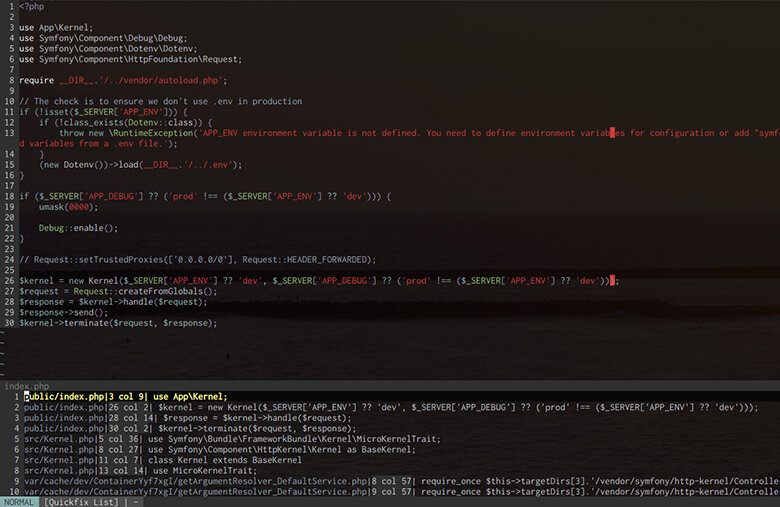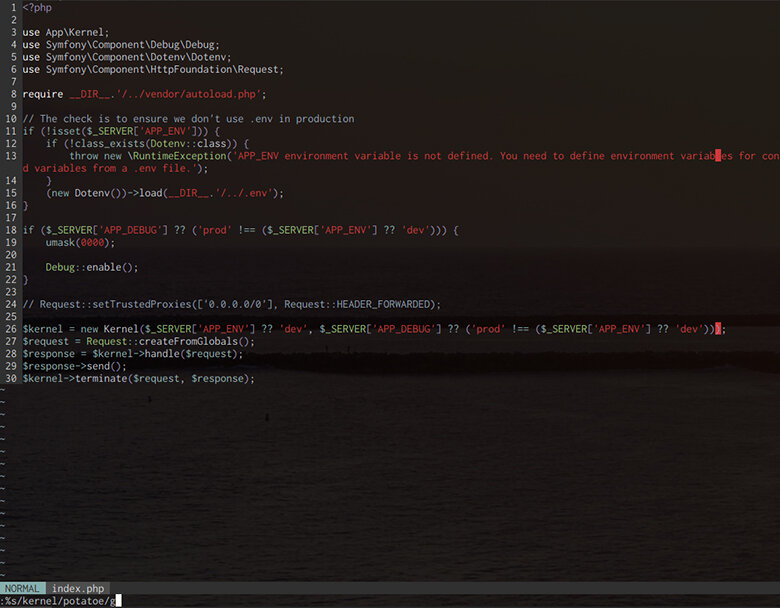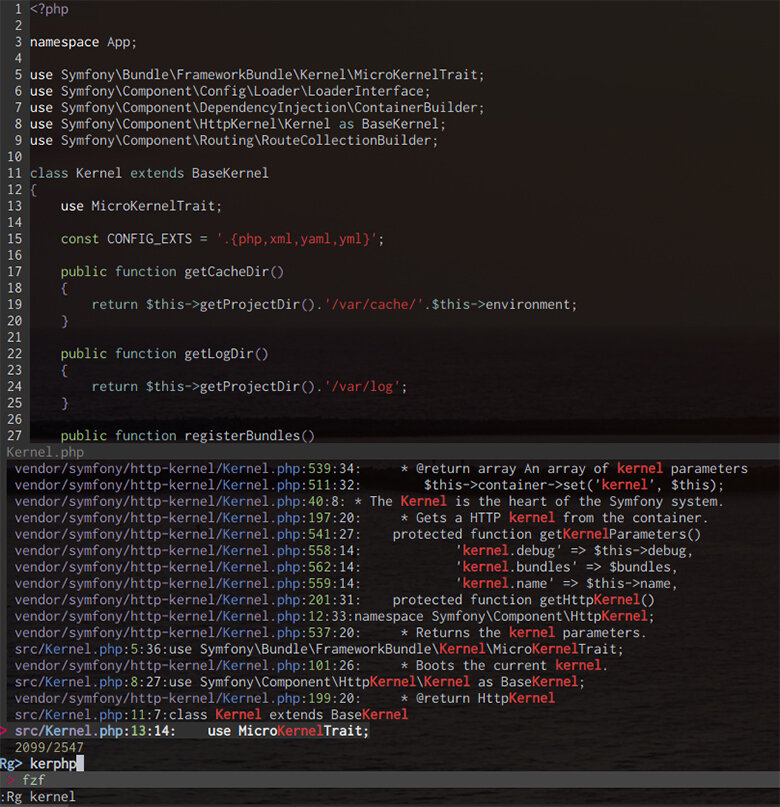
Can developers survive without a good search in their editor? Who has never used the famous find and replace trick in one or multiple files?
Nobody indeed.
The good new is: Vim search features are pure awesomeness. With a minimum of configuration, you can search whatever you want, wherever you want, at light speed.
We’ll see in this article how to:
- Search in the current file.
- Search in multiple files.
- Find and replace everything you dream of.
- Use great plugins to transform Vim in a Search Monster™.
Without the search features I’ll present you in this article, Vim would maybe not be part of my Mouseless Development Environment.
A little precision: I will often refer to Vim current working directory in this article. The ex command :pwd can tell you what’s yours. To change it, you can use :cd mydirectory.
If you don’t feel comfortable using Vim, I cover the basics you need to know here.
Thanks for everybody who helped me on this article, especially the nice Neovim Reddit community. I learned a ton from them!
Enough babbling. Let’s launch Vim, and let’s search! I invite you to try the tips of this article while you read them: it will help you learn and remember.
Vim Search in the Current File
Basics
To search in the current file, you just need to type / in normal mode. Then, you need to type your search pattern, press enter, and the result becomes highlighted in your file.
To go backward and forward through the results, you can type n and N (for next) respectively.
Using / will search forward in the file. If you need to directly search backward, you can use ? instead.
If you want to search again using the previous search pattern, // is your friend.
Vim Highlight Search
It’s practical to see the search highlighted in the file, but it’s not enabled by default. To do so, you can type the command :set hlsearch, or set it permanently in your vimrc.
If you use Neovim, the highlighting is set by default.
Clearing the Highlight
The command :noh in normal mode will clear this highlight you tried to get rid of by trying (almost) every button on your keyboard. You know, like when you tried to quit Vim the first time.
Since you don’t really want to type this command each time you do a search, you can map a key to this command in your vimrc. Personally, I use the following mapping: map <esc> :noh<cr>.
<esc> to anything. I use it for years without problem, but beware.Searching the Word Under the Cursor
To search the word under your cursor:
- Place your cursor on the word you want to search.
- Type
*org*.
As with /, every result will be highlighted.
To search for partial words (including word parts in the results), you can use the keystroke g*.
To search backward, you can use # or g#.
Search With Case Sensitive or Insensitive
If you want to ignore the case, here you go:
/search\C- Case-sensitive search./search\c- Case-insensitive search.
You can as well write the following command in your vimrc:
set ignorecase- All your searches will be case-insensitive.set smartcase- Your search will be case-sensitive if it contains an uppercase letter.
Be aware that ignorecase needs to be set for smartcase to work.
Vim Search in Multiple Files
Searching in one file is great, but what about a whole project? It’s where you realize that Vim is crazy fast.
Searching with vimgrep

vimgrep kernel **/*.php and :copen
Searching with vimgrep will populate the quickfix list (see :help quickfix and :help quickfix-window in Vim) with the result of the search.
It implies that you need to use the command :cnext (or :cn) and :cprev (or :cp) to go through the results (instead of n and N respectively).
You can as well open the quickfix window with :copen and go through the results.
For example:
:vimgrep pattern *- Search the pattern in every file of the working directory.:vimgrep pattern a.txt b.txt c.txt- Search the same pattern only in the files “a.txt”, “b.txt” and “c.txt”.:vimgrep pattern *.php- Search “pattern” in every php files.:vimgrep pattern **/*.php- Search “pattern” in every php files in the working directory and every subdirectory.
Quick tip: You can go through all your results by taping :cnext, and then using the keystroke @: which repeats your last command. Then, you can use @@ which repeat the previous @<whatever> (:help @@).
For more information about vimgrep, I strongly advice you to look at the excellent vimcast about it.
I encourage you to read Vim’s help about vimgrep by typing :help :vimgrep. Actually, I encourage you to use Vim’s help as often as you can.
Searching With grep
Vimgrep is good but unfortunately slow. As an alternative, you can use an external program (grep by default) directly in Vim, by using :grep. To configure the external program you want to use, you need to set grepprg (see :help grepprg). There’s an example how to do that below.
Using :grep and :vimgrep is similar. For example:
:grep mySearch *- Search every occurences ofmySearchin the working directory:grep mySearch a.txt b.txt c.txt- Search every occurences ofmySearchin the files a.txt, b.txt, c.txt
You know the drill: :help :grep.
Find and Replace
Substitution In the Current File
Vim has a powerful find and replace functionality thanks to the substitute (see :help :substitute) command.
Let’s look at some examples:
:s/pattern/replace/g- Substitute “pattern” by “replace” on the current line.:%s/pattern/replace/g- Substitute “pattern” by “replace” in the current file.:%s//replace/g- Substitute your last search by “replace” in the current file.
You may ask yourself: what the hell those letters and signs mean? Good question!
- The letter
sstands forsubstitute. - The keyword
%will target the entire file instead of the current line. You can use it with different commands in different context. - The flag
gmeans “global”: more than one occurrence is targeted. Without it, only the first occurrence in the file (or the in line) would be replaced.
The syntax is similar to the command line tool sed. If you need to add the character / in your pattern or in your replacement, you can do:
:s/pat\/tern/replace/g- Escape the/to match “pat/tern”:s#pat/tern#replace#g- Use another character as separator to match “pat/tern”.

Find and Replace One Occurrence at a Time
It’s simple to search and then decide if you want to keep or replace each result in a file:
- Execute a regular search with
/. - Use the keystroke
cgnon the first result to replace it. - Type
norNto go to the next result. - Use
.to replace the occurrence with the same replacement, or go to the next result if you want to keep it.
What’s this cgn keystroke, you may ask? What does it mean? If you read :help gn, you’ll see that gn is the same as n, except that it will start Visual mode and select the occurrence. We just do a change (c) on the next (selected) searched occurrence. From there, you can imagine that keystrokes like cgN or dgn will work as well.
With this technique, you can do a granular find and replace in the whole file.
Find and Replace in Multiple Files
To find and replace in multiple files, you can use the excellent Vim arglist. Think of it as an internal list of files you can modify.
If you want to replace an occurrence in every html and twig files, you can type the following:
:arg *.html- Populate the arglist with allhtmlfiles in the current working directory, and edit the first one.:argadd *.twig- Addtwigfiles to the arglist.:argdo %s/pattern/replace/ge | update- Replace the occurencepatternbyreplacein every file of the arglist.
Even if the argument list (:help arglist) and the buffer list (:help :buffers) are different, every files added in the argument list will be added in the buffer list.
You can delete files in one of these lists without changing the other. For example, :argdelete * will remove everything in your argument list.
At that point, you might scream to your screen, violently shacked by extrem curiosity: what means the flag e at the end of the substitute command? It prevents Vim to display an error message when the pattern is not found in a file.
What about doing a find and replace in the working directory and the subdirectories? You can populate the arglist as follow:
:arg **/*.html:argadd **/*.php
You need to find and replace in the files in the buffer list? Easy! I expected you to have more difficult questions. You can execute:
:bufdo %s/pattern/replace/ge | update
The argument list can be used with :grep or :vimgrep too. For example, you could search in your current buffer, and then apply the result to every file in the argument list. For example:
/vimarg *.mdvimgrep // ##
Here, // is expanded to last used search pattern (see :help search-commands), and ## to your argument list.
Now that your quickfix list has the results of your search, you can use :cdo to execute a command on each entry of the list. For example:
:grep pattern **/*.html:cdo s/blink/div/g | update
Every result in every file of your quicklist will replace blink with div.
Beyond Vanilla Vim: Search with External Plugins
It’s good to know how to search in bare bone Vim, especially when you’re lost in a remote server far aways from your lovely vimrc.
I have a good new: there are even more alternatives to vimgrep and grep. The plugins described here might change your search life forever!
Since we speak about Vim plugins, I wrote another article which list the necessary Vim plugins to build a Vim PHP IDE, in case you’re interested.
One Plugin to Rule Them All, One Plugin to Find Them
If there is one plugin I would take with me on a lost inhabited island (with a computer and Vim), it would be fzf.vim with its terminal twin fzf. Why?
- It’s blazing fast (written in Go). Einstein was wrong: you can go beyond light speed.
- It allows you to search in your terminal whatever file or history you want.
- It can be coupled with Vim to search in many stuff like buffers, tags, the command history, the open files history…
Here are some basic examples:
:Files- Search for a file in your working directory and subdirectories.:Buffers- Search for a file open in one of your buffer.:History- Search for a file in your open file history.
You can as well copy your filtered search in the quickfix list using alt-a, and use the good old :cdo command!
Search, Vim, Search! Faster!
fzf is a powerful tool, but it’s not enough to search a precise occurrence in a bunch of files. You need another crazy fast CLI: ripgrep.
This tool is similar to grep. Coupled to fzf, ripgrep will bring under your little fingers the best search engine I’ve ever seen in any IDE. No more, no less.
In order to link fzf with ripgrep, you can look at my fzf config file on Github.
Then you just have to enter the command :Rg pattern to search “pattern” in every file in the working directory.

If you don’t like fzf, you can still use ripgrep with the Vim command :grep. First, add the following to your vimrc:
if executable("rg")
set grepprg=rg\ --vimgrep
endif
We spoke quickly about grepprg above. You can use it to define what program to use for the :grep command.
Find and Replace in Multiple Files with Vim ferret
I sometimes use the plugin ferret. It allows you to search an occurrence in multiple files, select what results you want to replace, and finally replace them. If you have ripgrep installed on your system, this plugin will use it by default.
Here’s how it works:
:Ack pattern- Search in the working directory.:Ack pattern /path/to/directory- Search in the specified path and its subdirectories.
At that point, Ferret will populate the quickfix window with every result found.
You can delete the result by typing dd, in case you don’t want to replace it. You can as well type enter to open the file with the result highlighted.
Then, typing :Acks /pattern/replacement/ will replace every results still present in the quickfix window.
Simple, granular, and powerful: that’s what we want.
CocSearch
If you use the plugin coc.nvim already, you can use the very nice :CocSearch. You can do for example:
:CocSearch pattern */**.html
It will open a new window with the result of your search. You can simply modify it and save.
Even better: it uses ripgrep under the hood, so you can pass to it any argument. For example, to display (and be able to modify) 10 lines after the search result in each file:
:CocSearch pattern */**.html -A 20
Vim is Now Your Personal Search Beast
This overview will bring you whatever search functionality you need as a developer.
I personally use built-in vim search functionality when I search (or search in replace) in one file. When the search needs to be in a whole project, or in multiple files, I use the combo:
If you know other functionalities (or plugins) which can bring even more coolness in our search life, the comment section is ready for you.
You know, sharing is caring.
